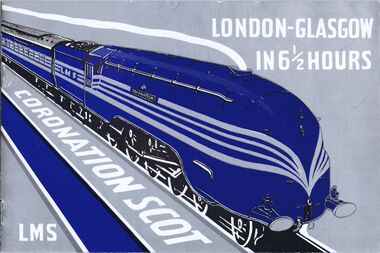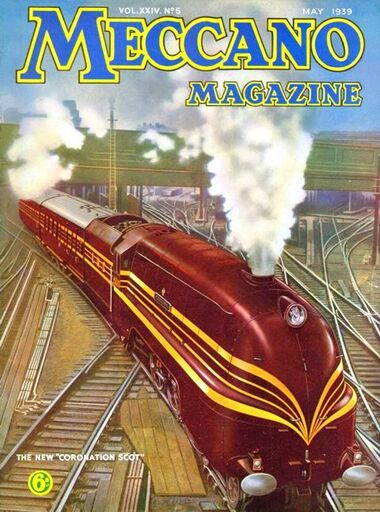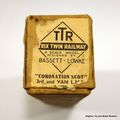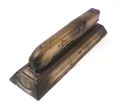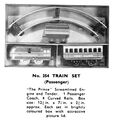Category:Coronation Scot (train)
Advance publicity brochure for the train, printed for LMS in black, blue and silver ink (1937) [image info]
The museum's original 1930s Bassett-Lowke Coronation 6220 running on our period gauge 0 layout, Train Running Day 2012 [image info]
ACE Trains gauge 0 Coronation 6220, November 2012 [image info]
Coronation Scot exhibition logo [image info]
The Coronation Scot (1937-1939) "Art Deco"-styled bullet-train was Britain's finest stream train, its luxurious 1939 incarnation representing the high point of Britain's Golden Age of Steam, before World War Two changed the world forever. It represented the peak optimism of the late 1930s, when the future was going to be glossy, luxurious, opulent, designer-styled and streamlined.
About the train
The streamlined Coronation Scot was part of a wider movement in the 1930s towards futuristic designs, as society recovered from World War One and started to think about how the Brave New World ought to look. The futurist movement was particularly strong in Germany (Fritz Lang's seminal film "Metropolis" was released in 1927), and a new focus on engineering and technological design was taking over. Where Art Deco had stressed functionality and a design ethos that paid tribute to the qualities of the materials used, those materials had tended to be brick and wood and tile. For the new modernism, the materials were steel and aluminium, and the story that they carried wasn't the nobility of the traditional craftsman, but of an apparently unstoppable acceleration into the future. Machines were becoming faster and stronger and more powerful each year, and British railway companies vied with each other to see whose express trains could claim to be the very fastest.
Unlike the more complex outlines and surfaces of contemporary American locomotives (symbolising industry), European locomotives tended to be smoother, and without without the same degree of external piping or the "bells and whistles" of their US counterparts, and the destination that they were hurtling towards wasn't just the station at the end of the line, it was The Future.
Germany's industrial emphasis had always used engineering prowess to give it the edge in a country whose local industrial raw materials were limited, and the streamlined Berlin-to-Hamburg "Flying Hamburger" express train in 1932 broke speed records and created a view of the future in which trains were sleek and smooth and rounded and integrated with their locomotives. This was followed (again in Germany) by the streamlined Borsig 005-02 locomotive and the shockingly styled Henshel-Wegman steam locomotive, an uncompromising elongated silver bubble that looked more like a blob of molten solder on rails than a conventional steam locomotive.
Over in Britain, designers who'd seen the German trains decided to exploit these new streamlining ideas to squeeze out an increase in speed and a decrease in coal consumption that might give their engines the edge over their competition ... and the highly stylised look, which screamed "speed" didn't hurt, either. The Coronation Scot wasn't just a streamlined locomotive, it followed the German idea of treating the whole train as a single integrated piece of design, and the locomotives and their coaches were designed specially to match, finished in the old Caledonian Railway's blue livery, with silver stripes starting at the nose of the locomotive and running along the full length of the train to drive home the idea that this was a single object. The stripes also helped to make the locomotive look more different to the German 005-02, whose "nose" had had some stylistic similarities.
The Coronation Scot went into service on 5th July 1937.
The blue 1937 Coronation Scot
The first five Coronation-class locomotives (and their three sets of nine carriages) were all finished in blue to evoke the distinctive blue paintwork of the Caledonian Railway, which the LMS had absorbed, but also had four distinctive silver "speed stripes" that started at a point on the locomotive's nose, and arched up to run along the full length of the locomotives and their cars.
These first coaches were based on standard LMS rolling stock designs, but were customised to be continuous with the lines of the Coronation-class locomotives that would haul them, and had various design features to make them run better and more quietly at the higher speeds that were expected from the new train.
Just before the train went into service, the LMS took the train out on a trial run with the press invited, and it soon became clear to the journalists onboard (as they watched an airplane following the train and filming its progress) that LMS were using the occasion to try to set a new world speed record for a steam locomotive, and Coronation 6220 duly reached speeds of around 113-114 mph on the run, making it the world's fastest steam train (until Mallard broke the record a year later, in 1938). As Coronation hurtled enthusiastically along the section of "fast" track, it became clear that braking for the following set of points and curves was going to be problematic, and Coronation sped through the next section at double the speed limit, leading to some breaking of crockery and a certain amount of alarm that the train was about to derail. LMS didn't try to break the speed record again, but it left many feeling that it hadn't been established just how fast the new Coronation Class could really go, given a suitable section of track.
Even after Mallard took the speed record on behalf of the streamlined "A4" locos, the "Coronations" still held the record for being the most powerful steam locomotives ever built for the British railway system.
The prototype red 1939 Coronation Scot - "The Lost Train"
The red "US promotional tour" Coronation Scot train on the cover of Meccano Magazine, in May 1939. World War Two broke out a few months later, on 1st September [image info]
After the success of the "blue" locomotives and carriages, LMS decided to build another three sets of more luxurious coaches, and to have these and the locomotives that pulled them finished in LMS' own colours.
Five more of the streamlined locomotives were built, finished in "crimson lake" rather than blue, with gold striping rather than silver, with the first completed set of matching carriages (referred to internally at LMS as "the American train") built to go on tour around the United States to show off the new train and prove that it could compete against the premium Pullmans.
As well as its new leather armchairs and leather-on-felt sound-absorbing wallcoverings, the new train made the ride smoother by using "shared bogeys" -- instead of having two bogies on each carriage, six of the cars were "paired-off", with a single shared bogey acting as the connecting joint. This gave the "special" carriages a longer wheelbase and reduced vibration between cars. The new train also featured a sleeper car designed more for the US market than for the UK, and once the "US train" was completed and shipped, LMS continued work on the other two sets of carriages, to go straight onto the UK rail network.
The new "sample" red train was duly shipped off to the United States in 1939 for a promotional tour (including a guest appearance at the 1939 New York World's Fair) that took it around the US rail system, hauled by Coronation-Class locomotive 6229 (given a temporary cosmetic makeover as Coronation 6220), and temporarily fitted with a bell and headlight to comply with US railway regulations.
Disaster struck the new plans for the new Coronation Scot in 1939 with the outbreak of World War Two. With the rail network now focusing on wartime freight, the luxury high-speed service was cancelled, and although LMS did build some more of the carriages, post-war austerity meant that the new trains were never completed.
Meanwhile, the one set of luxury carriages for the train that did exist was now marooned on the wrong side of the Atlantic, and stayed there until after the war.
The subject of the "red" train is a painful one for UK train enthusiasts, since the finest example of an integrated, streamlined British-designed steam train ever produced in Britain spent its entire working life on foreign track, and most UK enthusiasts never got to see the train in action on home soil.
the War Years and beyond
Although more of the powerful Coronation Class locomotives were built, the emphasis on prestige and glamour was now gone, and although LMS (perhaps a little optimistically) produced more of the locos in streamlined red and gold, the new locos were then finished in wartime black. With the new focus on using the locomotives as powerful "workhorses" rather than as high-speed passenger express engines, with rails services being pushed to their operating limits, and with poor maintenance and heavy traffic resulting in many sections of line being assigned a 60mph speed-limit, the streamlining that had already been fitted (which only had a significant effect above 80mph) was stripped to improve servicing turnaround times.
The intense use that the railways then saw during the War Years effectively "wore out" a lot of the country's railway infrastructure, as the system was driven as hard as it could be for the war effort, transporting civilians and troops and war freight around the country. The UK network arguably never really recovered from this period of intense use and underinvestment, and after the rail network had been run into the ground, and then endured decades of further post-war neglect (and then endured the Beeching cuts), it was never really the same again.
As a result, some people consider the 1939 "red" Coronation Scot to represent the fleeting high-point of Britain's railway history, with the fact that the new train only ran briefly on UK track under its own power (for some publicity photographs) making the story even more poignant.
neglect
With its service cut cruelly short by WW2 and all its locomotives stripped of their streamlining, and with nobody in the UK having ridden the "red" train in service in the UK (and few having even seen it, outside of the locomotive works), the story of the Coronation Scots (blue and red) faded from popular consciousness and, like the UK space and computing programmes, became another forgotten story of successful British engineering that was foiled by outside factors. The de-streamlined locomotives did continue to have successful careers (as the "Duchess Class"), as the most powerful locomotives on the British railway system, but after only running for two years and after having all its locomotives de-streamlined and reclassified, the Coronation Scot faded from history.
The public did remember the A4 series of streamlined locomotives epitomised by the Mallard, partly because the A4's more compartmentalised fairing design allowed that series to have their streamlining removed from the critical wheel areas while leaving the rest of the chisel-shaped streamlining in place. Until the 229 Club and the National Railway Museum eventually re-fitted a streamlined fairing to their preserved Duchess of Hamilton 6229 in May 2009, there were no surviving examples of a streamlined Coronation Class locomotive in existence.
The Coronation Scot in popular culture

Coronation Scot Exhibition
the locomotives
trains: 1937 - 1939 - 1940
greatest? - streamlining - advertising - trivia - models and kits
The Coronation Scot was one of the few trains to have a popular piece of music written for it, "Coronation Scot", by Vivian Ellis. For many years, the piece was one of the most recognisable theme tunes used on BBC radio.
The train's short run, and the locomotives' rapid switch to "wartime black" and de-streamlining means that almost all of the train's images in the media (and almost all images of the locomotives with their streamlining) date from a very small "time-window" of around two years within 1937-39, with most of those relating to the barrage of publicity surrounding the ill-fated "red train"'s abortive US launch in 1939.
See also:
External Links
- BBC News, "In pictures: Styling an Era" (bbc.co.uk)
- Images of the Coronation Scot (YouTube.com) - with the Coronation Scot theme by Vivian Ellis
- Coronation Scot Train Running Day, 2012, Brighton Toy and Model Museum (youtube.com)
Subcategories
This category has the following 3 subcategories, out of 3 total.
C
- Coronation Scot 1939 (3 P, 18 F)
Pages in category ‘Coronation Scot (train)’
The following 22 pages are in this category, out of 22 total.
C
- Coronation Class locomotive card model (Micromodels Set MII)
- Coronation locomotive 6220 (Bassett-Lowke)
- Coronation Scot carriage (Trix Twin Railway)
- Coronation Scot coach card model (Micromodels Set X)
- Coronation Scot First Class Brake Car 6202 (Exley for Bassett-Lowke)
- Coronation Scot First Class Car 7720 (Exley for Bassett-Lowke)
- Coronation Scot Kitchen Car 2704 (Exley for Bassett-Lowke)
- Coronation Scot Kitchen Car 2707 (Exley for Bassett-Lowke)
- Coronation Scot Restaurant Car 7507 (Exley for Bassett-Lowke)
- Coronation Scot Third Class Brake Car 7602 (Exley for Bassett-Lowke)
- Coronation Scot Third Class Car 4104 (Exley for Bassett-Lowke)
- Coronation Scot Third Class Car 4107 (Exley for Bassett-Lowke)
- Coronation Scot Third Class Car 5027 (Exley for Bassett-Lowke)
- Coronation Scot US Tour presentation set 2/347 (Trix Twin Railways)
L
Media in category ‘Coronation Scot (train)’
The following 79 files are in this category, out of 79 total.
- 1939 New York Worlds Fair Coronation Scot brochure red.jpg 2,137 × 1,740; 1.14 MB
- 1939 pre New York Worlds Fair Coronation Scot brochure blue sketches.jpg 1,873 × 1,510; 489 KB
- 1939 pre New York Worlds Fair Coronation Scot brochure blue.jpg 1,889 × 1,508; 486 KB
- A Book of Trains (Puffin Picture Book).jpg 800 × 650; 118 KB
- Advert 1939 Mobiloil CoronationScot.jpg 300 × 393; 39 KB
- Bassett-Lowke catalogue 1937-38 CSblue back.jpg 908 × 603; 71 KB
- Bassett-Lowke catalogue 1937-38 CSblue front.jpg 910 × 611; 90 KB
- Bassett-Lowke catalogue 1937-38 streamliners.jpg 1,280 × 960; 244 KB
- Bassett-Lowke catalogue 1938-39 CSred back.jpg 911 × 607; 77 KB
- Bassett-Lowke catalogue 1938-39 CSred front.jpg 913 × 607; 95 KB
- Book TheDuchesses AndrewRoden.jpg 760 × 1,160; 87 KB
- Box end label for Coronation Scot carriage (Trix Twin Railway).jpg 800 × 799; 381 KB
- BTMM Coronation 6220 frontview TRD2012.jpg 2,000 × 1,500; 389 KB
- BTMM Coronation 6220 quarterview TRD2012.jpg 1,500 × 1,124; 275 KB
- Club Saloon Brake Compartment, Coronation Scot US tour (MRN 1939-03).jpg 836 × 1,200; 173 KB
- Club Saloon, Coronation Scot US tour (MRN 1939-03).jpg 1,200 × 944; 312 KB
- Coronation 6220 Bassett-Lowke ad 1939.jpg 4,324 × 1,802; 479 KB
- Coronation 6220 wings (Meccano Magazine).jpg 1,150 × 1,069; 129 KB
- Coronation Class - blueprint, front.jpg 768 × 1,024; 137 KB
- Coronation loco 6220, US tour, profile (MRN 1939-03).jpg 2,400 × 711; 324 KB
- Coronation loco Area 01.jpg 640 × 480; 187 KB
- Coronation Scot at BTMM logo.png 1,920 × 1,080; 169 KB
- Coronation Scot boardgame board.jpg 2,512 × 1,692; 915 KB
- Coronation Scot boardgame lid.jpg 800 × 500; 79 KB
- Coronation Scot cap-badge.jpg 800 × 335; 55 KB
- Coronation Scot in the United States.jpg 1,205 × 1,624; 428 KB
- Coronation Scot model, British Empire Exhibition (MRN 1938-09).jpg 1,800 × 966; 379 KB
- Coronation Scot nine-car train (Bassett-Lowke).jpg 1,200 × 562; 468 KB
- Coronation Scot publicity brochure, silver ink (LMS 1937).jpg 2,182 × 1,455; 533 KB
- Coronation Scot US (MRN 1939-03).jpg 2,400 × 2,339; 729 KB
- Coronation Scot US special-features p1.jpg 1,205 × 1,624; 405 KB
- Coronation Scot US special-features p2.jpg 1,205 × 1,624; 418 KB
- Coronation Scot US, special coaches (MRN 1939-03).jpg 2,400 × 834; 355 KB
- Coronation6220 blueprint side detail nose.jpg 1,728 × 2,355; 697 KB
- Coronation6220 HornbyR685 front.jpg 1,536 × 2,048; 260 KB
- Coronation6220 HornbyR685.jpg 1,024 × 768; 98 KB
- CoronationScot coach 1st HornbyR422.jpg 680 × 510; 43 KB
- CoronationScot GOSV 35c 01.jpg 955 × 714; 106 KB
- CoronationScot GOSV 35c 02.jpg 953 × 711; 140 KB
- Corridor First Lounge Coronation Scot US (MRN 1939-03).jpg 1,200 × 960; 310 KB
- Duchess of Hamilton loco 6229, N gauge (Dapol).jpg 1,024 × 577; 111 KB
- Gilbert Thomas and B-L Coronation 6220 (MRH12ed 1942).jpg 1,325 × 1,600; 464 KB
- Hornby R864 Coronation 6220 locomotive front-angle.jpg 1,536 × 1,536; 146 KB
- Hornby R864 Coronation 6220 locomotive side.jpg 1,024 × 768; 91 KB
- Hornby R864 Coronation 6220 locomotive tender.jpg 1,024 × 768; 74 KB
- Interior of First Class Sleeper, Coronation Scot US tour (MRN 1939-03).jpg 898 × 1,200; 194 KB
- LMS Coronation Scot small paperweight and box.jpg 1,632 × 1,224; 237 KB
- LMS Coronation Scot small paperweight.jpg 1,200 × 1,100; 89 KB
- LMS orange Coronation Scot poster (Bryan de Grineau).jpg 1,425 × 2,284; 647 KB
- LMS Power (book, Edward Talbot).jpg 473 × 600; 55 KB
- Locomotives, written by W.J. Bassett-Lowke, drawn by Paul. B. Mann.jpg 1,024 × 840; 133 KB
- MeccanoMagazine June 1944.jpg 442 × 660; 54 KB
- MeccanoMagazine May1939 NewCoronationScot.jpg 480 × 647; 91 KB
- Micromodels Coronation Class locomotive MII angle.jpg 1,024 × 629; 71 KB
- Micromodels Coronation Class locomotive MII perspective.jpg 2,048 × 1,024; 208 KB
- Micromodels Coronation Class locomotive MII side.jpg 2,048 × 1,024; 225 KB
- Micromodels Coronation Scot carriage Set X.jpg 1,024 × 512; 63 KB
- Pacific Steam (book, Martin Evans).jpg 664 × 1,056; 67 KB
- Red Coronation Class locomotive toy (TTI Stoke-on-Trent).jpg 960 × 768; 66 KB
- Red Coronation Scot jigsaw (Falcon).jpg 1,921 × 1,347; 315 KB
- The Coronation Scot Ascending Shap Fell.jpg 1,665 × 1,363; 235 KB
- The Coronation Scot book cover Edward Talbot.jpg 360 × 463; 27 KB
- The Exhaust Steam Injector (Metcalfe's Patents).jpg 708 × 903; 143 KB
- The Prince, Streamlined Train Set, Wells Brimtoy 354 (BPO 1955-10).jpg 1,739 × 1,823; 965 KB
- The Romantic Story of the Iron Road (book, Cecil J. Allen).jpg 768 × 1,024; 139 KB
- TheCoronationScot RailwayGazette blueprint.jpg 1,024 × 447; 129 KB
- TheCoronationScot RailwayGazette cover.jpg 500 × 650; 43 KB
- TheTrackOfTheCoronationScot cover back.jpg 1,200 × 2,779; 172 KB
- TheTrackOfTheCoronationScot cover front.jpg 1,200 × 2,779; 165 KB
- TheTrackOfTheCoronationScot flyleaf.jpg 809 × 922; 63 KB
- TheTrackOfTheCoronationScot map.jpg 2,415 × 2,786; 717 KB
- TheTrackOfTheCoronationScot specifications.jpg 1,220 × 1,397; 285 KB
- TrixTwin CoronationScot.jpg 517 × 493; 39 KB
- TTR catalogue 1939-40 cover.jpg 1,722 × 2,820; 816 KB
- TTR Coronation Scot 1939 red US tour set.jpg 1,717 × 2,832; 643 KB
- Wonder Book of Railways (Coronation Scot), dustjacket.jpg 2,497 × 1,208; 638 KB
- Wonder Book of Railways (Coronation Scot), front.jpg 1,700 × 2,170; 543 KB
